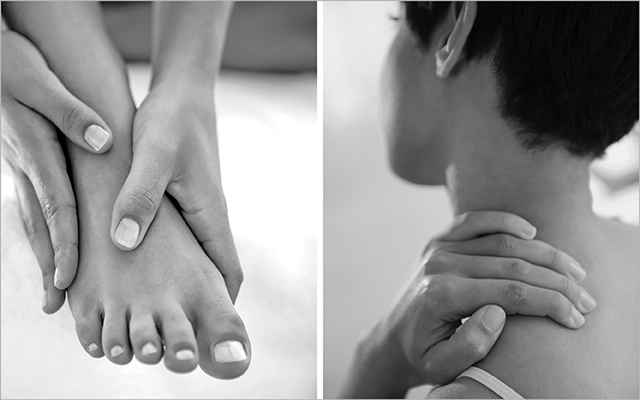In his prime, my grandfather lived an active life, walking and swimming for hours every day. As he aged and suffered the loss of his wife, his experience of the physical world gradually narrowed. In his 90s, with his mobility increasingly limited, the highlight of his week was a one-hour massage. That healing touch relieved his pain and helped him reconnect with his body.
Touch orients us in the world and connects us to one another. It’s why we give babies skin-to-skin contact immediately after birth, and it’s why we might offer a handshake when meeting a stranger or squeeze a friend’s arm to convey sympathy or support.
We live in an era of constant communication but waning in-person social interaction. Mounting evidence points to a loneliness epidemic, with nearly half of Americans reporting that they sometimes or always feel isolated or left out. That emotion carries real health implications: It’s been linked to serious conditions that include heart disease, depression, and Alzheimer’s.
“The changes in our society have perpetuated problematic touch deprivation, and we don’t necessarily know the long-term impacts,” notes Niki Munk, PhD, LMT, associate professor of health sciences at Indiana University’s School of Health and Human Sciences. “So many of us have a bit of a touch hunger, even when we’re not aware of it.”
We know that welcome physical touch can abate loneliness. It can also ease stress, lower blood pressure, boost immune function, and improve self-esteem, while reducing the risk for many chronic illnesses. Plus, many forms of physical contact boost levels of the feel-good hormone oxytocin, so more touch can increase our sense of trust and strengthen our bonds with loved ones. Fortunately, getting more of it in our lives is easier than we might think.
Give more hugs.
Welcome embraces may convey some pain-relief benefits because of the associated release of oxytocin. One University of North Carolina study found that women who hug their spouses more frequently experience lower heart rate and blood pressure, minimizing two key risk factors for cardiovascular disease and stroke.
Other research suggests that hugs protect us against respiratory infections and help us manage interpersonal conflict and stress.
“We’re so busy, and touch gets pushed to the background. It’s time to bring it back to the mindfulness of looking your partner in the eyes and giving a hug when you greet each other or say goodbye,” says Melissa Young, MD, a physician at the Cleveland Clinic Center for Functional Medicine. “When you greet your friends, if it’s appropriate and welcome, give a hug.”
Like other forms of touch or social connection, hugs have been shown to engage the vagus nerve, which connects your brain to your heart, lungs, and gut, and also helps regulate your nervous system. Stimulating it can slow your heart rate, lower your blood pressure, and reduce inflammation throughout your body.
Engage in social touch.
If you’re not a hugger, you can still reap some of the benefits of touch through less-intimate forms of contact, like shaking hands or patting a friend on the shoulder.
In her book Love 2.0, Barbara Fredrickson, PhD, notes that these small moments of connection — which close friends or strangers alike can share — are examples of “positivity resonance . . . the doorways through which caring and compassionate communities are forged.”
Touch could even save your life. Research from the University of California at Berkeley School of Public Health found that doctors who make eye contact with their patients or pat them on the back may produce higher survival rates.
The advantages of these moments of connection include increased happiness, social integration, and resilience. Those resources, according to Fredrickson, will better equip you to cultivate more of those micro moments, from which you’ll both give and receive lasting benefits.
“This repeated back-and-forth sharing,” she writes, “however small or subtle, helps establish and strengthen healthy communities and cultures.”
Try bodywork.
Stress can contribute to muscle tension, causing pain and restricting circulation. Pressure on those tense spots, or related areas, can relieve stress as well as discomfort.
Because bodywork, such as massage, stimulates pressure receptors under the skin, Tiffany Field, PhD, director of the University of Miami’s Touch Research Institute at the Miller School of Medicine, says it is particularly effective at activating the vagal system, which eases anxiety.
For couples, giving a massage has the same physical and emotional benefits as receiving one, perhaps because of the empathetic touch involved. “Therapeutic touch helps people feel connected to themselves, and to the greater empathetic society,” says Munk. “It brings people out of isolation into the moment.”
Massage can also promote deeper, less disturbed sleep and reduce symptoms of depression. (For more on the benefits of massage, see “Mmm, Massage: Surprising Ways Massage Heals the Body and Mind”.)
Experiment with self-massage.
If you can’t afford massage therapy, consider self-massage. You can relieve pain and stimulate vagal activity by applying pressure to trigger points with a hand, tennis ball, or foam roller, Munk says. (For more on how to be your own bodyworker, see “Be Your Own Massage Therapist”.)
You may also consider other touch-based healing modalities, such as the Emotional Freedom Technique, or EFT. Also called “tapping,” the practice combines ancient Chinese acupressure and modern psychology. By tapping on acupressure points — which lie along channels of energy in the body called meridians — you can relieve anxiety, pain, depression, and other ills.
“When we do this, we send a calming signal to the amygdala,” says Nick Ortner, author of The Tapping Solution. “It tells the body it’s safe. We add in other language and other parts of the process to reinforce that feeling of safety and relaxation.”
Find calming alternatives.
Because of past trauma or a neurological condition, such as autism, some people might experience physical touch as stressful or upsetting rather than soothing or therapeutic.
“For someone who’s been traumatized, their mind is in such a protective mode that they don’t want to be vulnerable enough to be touched,” explains Matthew Sanford, author of Waking: A Memoir of Trauma and Transcendence and founder of the nonprofit Mind Body Solutions in Minneapolis. “Touch that isn’t welcome, that isn’t within the realm of someone’s conditions of safety — that can quickly feel violent.”
But even those who are touch-averse can benefit from other forms of physical contact. Interacting with domestic animals has been shown to convey a wide range of positive effects, such as improved mental health, decreased feelings of stress and fear, and lowered risk of cardiovascular disease.
Researchers at the University of Tel Aviv found that petting a rabbit or even a turtle reduced people’s reported anxiety level.
“You’re moving the skin in your hand, and that can have positive effects,” explains Field. “And when you rub a pet, the pet gets a great massage, too.”
People who prefer to avoid human touch can also benefit from predictable pressure. A weighted blanket, for example, provides the kind of deep touch pressure used in swaddling a newborn. It simulates a comforting hug and calms the nervous system. (For more on whether a weighted blanket could be right for you, see “Can a Weighted Blanket Help My Insomnia?”)




This Post Has 0 Comments